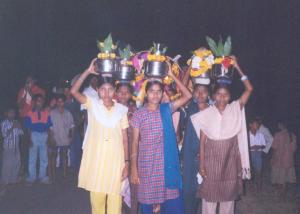Issue Date: January 23, 2004
Tribal village Mass embraces scripture, tradition and culture By FRANCIS GONSALVES Life, for the adivasis (aboriginals) of South Gujarat, India, springs from the womb of Mother Earth and is a joyous celebration of God’s cosmic presence. Thus, at the mission house at Unai, in Gujarat’s Navsari district, the adivasi community celebrates the wonders wrought by Varle Dev -- “God above.” Here, life leavens liturgy, sacramentalizing tribal life and Jesus’ sacrifice in symbols, songs and dance. “We strongly feel that this is our Mass,” said Leelaben Kokana, an active member of a women’s group in the community. “We prepare our Mass, participate in it, and it prepares us for life.” Adivasi liturgy involves the whole person, the community and the cosmos. Jesuit missionary Fr. Ignacio Galdos, who has ministered to tribal Gujarat for three decades, explained, “In tribal villages liturgy has evolved as a triadic encounter embracing scripture, tradition and adivasi culture. Liturgy appeals to the whole person -- body, heart, spirit -- the whole community, and the universe.” The Dev chapri (“God’s abode”) is built by pooling tribal talents and toil using local material such as teak, bamboo, stones, mud and cow dung. The priest is welcomed with chandlo (red powder), rice and a garland of flowers. Then, to the accompaniment of harmonium, drums and cymbals, the priest enters the chapel preceded by dancers. Lamps and incense sticks are lit. To awaken the awareness of communion with all of creation, a “rite of presence” of the Kokana tribe is performed. The priest announces, “We are all children of God and live in continuous contact with nature. So, according to our way of life, let us call God above, our ancestors and the whole cosmos to take part in this Eucharist with us.” The community responds, “We are all here with you, O Lord!” Then, litany-like, the priest calls out the names of God the Father, Jesus, the Spirit, Mother Mary, St. Joseph, angels, tribal ancestors, the universe, earth, sun, moon, mountains, forests, flowers, fruits, rivers, seas, animals, birds, relatives, friends, enemies and all present. After each mention, all enthusiastically exclaim, “Jaamin!” meaning, “Present!” The Bible is carried aloft in procession by dancers and the narrator, a catechist skilled in adapting biblical stories to adivasi myths of the creation of the world, the fall of humankind, the division of tribes, the story of the deluge, and the like. Then the priest proclaims and interprets the Gospel after tribal leaders bless him and request that he explain God’s word to them. The community renews its baptismal promises and performs the Kokana tribe’s beda-bedi reconciliatory rite that is employed after conflicts. Traditionally, erring parties assemble before the community, ask for pardon, then pour liquor into each other’s leaf-cups and drink it peacefully. Bhagubhai Gamit, an experienced catechist, says, “At Mass, the priest and four elders symbolically exchange and drink water from leaf-cups, reminding us of the beda-bedi and the fact that Jesus, too, drank the cup of suffering for our sake.” Among the Vasava tribals, the eldest son -- called the “first vasavo” -- leaves his paternal home and settles faraway to build a new house. Tribals consider Jesus as “First Vasavo” who leaves his Father’s house to re-create a new family and redeem humankind. Says Jesuit Fr. Thomas Pereira, “The spirit of sacrifice is strong among tribals. Adivasis easily identify with Jesus’ sacrifice and find strength in him.” Symbolic of their self-offering, adivasis bring to the altar the produce of the land. The eucharistic prayer remains unaltered except that the post-consecration prayers are interspersed with the refrain: “We are your children. We pray to you with confidence.” Three women perform an adoration dance with flowers, an oil lamp and incense while three men prostrate themselves before the raised chalice and paten. “The Our Father is sung after Communion just before the final blessing,” says catechist Manchubhai Kokana, “for, after eating from one thali [plate], we believe that we must live peacefully as children of one Abba above and offer ourselves just as Jesus did.” When I preside over tribal Eucharists, I remember Pope John Paul II’s words in his recent encyclical letter Ecclesia de Eucharistia: “Even when it is celebrated on the humble altar of a country church, the Eucharist is always in some way celebrated on the altar of the world.” Gujarat’s tribal church beautifully brings its world to the altar, and lets liturgy alter life. Jesuit Fr. Francis Gonsalves lectures in systematic theology at Vidyajyoti College of Theology in Delhi, India. National Catholic Reporter, January 23, 2004 |
